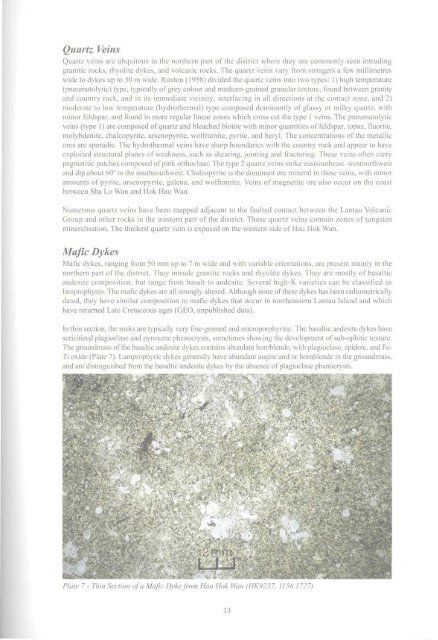5 - HKU Libraries - The University of Hong Kong
5 - HKU Libraries - The University of Hong Kong
5 - HKU Libraries - The University of Hong Kong
Create successful ePaper yourself
Turn your PDF publications into a flip-book with our unique Google optimized e-Paper software.
Quartz VeinsQuartz veins are ubquitous in the northern part <strong>of</strong> the district where they are commonly seen intrudinggranitic rocks, rhyolite dykes, and volcanic rocks. <strong>The</strong> quartz veins vary from stringers a few millimetreswide to dykes up to 30 m wide. Ruxton (1958) divided the quartz veins into two types: 1) high temperature(pneumatolytic) type, typically <strong>of</strong> grey colour and medium-grained granular texture, found between graniteand country rock, and in its immediate vicinity, interlacing in all directions at the contact zone, and 2)moderate to low temperature (hydrothermal) type composed dominantly <strong>of</strong> glassy or milky quartz, withminor feldspar, and found in more regular linear zones which cross cut the type 1 veins. <strong>The</strong> pneumatolyticveins (type 1) are composed <strong>of</strong> quartz and bleached biotite with minor quantities <strong>of</strong> feldspar, topaz, fluorite,molybdenite, chalcopyrite, arsenopyrite, wolframite, pyrite, and beryl. <strong>The</strong> concentrations <strong>of</strong> the metallicores are sporadic. <strong>The</strong> hydrothermal veins have sharp boundaries with the country rock and appear to haveexploited structural planes <strong>of</strong> weakness, such as shearing, jointing and fracturing. <strong>The</strong>se veins <strong>of</strong>ten carrypegmatitic patches composed <strong>of</strong> pink orthoclase. <strong>The</strong> type 2 quartz veins strike eastsoutheast-westnorthwestand dip about 60° to the southsouthwest. Chalcopyrite is the dominant ore mineral in these veins, with minoramounts <strong>of</strong> pyrite, arsenopyrite, galena, and wolframite. Veins <strong>of</strong> magnetite ore also occur on the coastbetween Sha Lo Wan and Hok Hau Wan.Numerous quartz veins have been mapped adjacent to the faulted contact between the Lantau VolcanicGroup and other rocks in the western part <strong>of</strong> the district. <strong>The</strong>se quartz veins contain zones <strong>of</strong> tungstenmineralisation. <strong>The</strong> thickest quartz vein is exposed on the western side <strong>of</strong> Hau Hok Wan.Mafic DykesMafic dykes, ranging from 50 mm up to 7 m wide and with variable orientations, are present mainly in thenorthern part <strong>of</strong> the district. <strong>The</strong>y intrude granitic rocks and rhyolite dykes. <strong>The</strong>y are mostly <strong>of</strong> basalticandesite composition, but range from basalt to andesite. Several high-K varieties can be classified aslamprophyres. <strong>The</strong> mafic dykes are all strongly altered. Although none <strong>of</strong> these dykes has been radiometricallydated, they have similar composition to mafic dykes that occur in northeastern Lantau Island and whichhave returned Late Cretaceous ages (GEO, unpublished data).In thin section, the rocks are typically very fine-grained and microporphyritic. <strong>The</strong> basaltic andesite dykes havesericitized plagioclase and pyroxene phenocrysts, sometimes showing the development <strong>of</strong> sub-ophitic texture.<strong>The</strong> groundmass <strong>of</strong> the basaltic andesite dykes contains abundant hornblende, with plagioclase, epidote, and Fe-Ti oxide (Plate 7). Lamprophyric dykes generally have abundant augite and/or hornblende in the groundmass,and are distinguished from the basaltic andesite dykes by the absence <strong>of</strong> plagioclase phenocrysts.Plate 7 - Thin Section <strong>of</strong> a Mafic Dyke from Hau Hok Wan (HK9237, 1156 1727)33

















